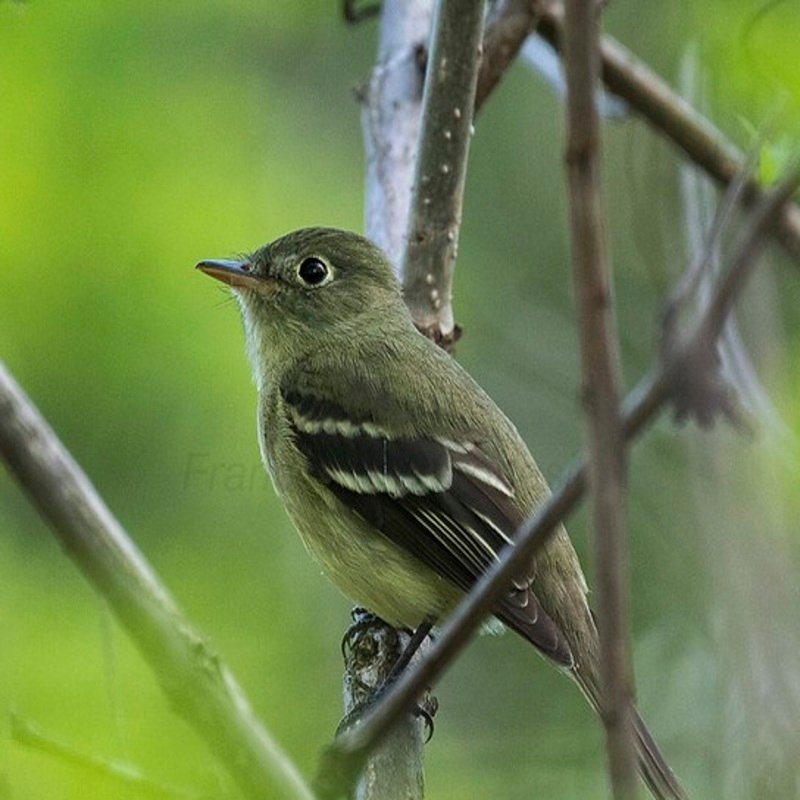The least flycatcher, Empidonax minimus is a little insect-eating bird (sometimes called chebec or checker due to the sound it makes). It is eastern North America’s tiniest Empidonax flycatcher. Due to the similarities in their songs and appearances, Hammond’s flycatcher was long believed to be the least flycatcher’s closest relative. However, mitochondrial DNA study revealed that the least flycatcher is genetically distinct from its congeners and lacks sister taxa.
Quick Overview: Empidonax Minimus – Least Flycatcher
Body size: Around 5.25 in (13 cm) and a weight of 11 g (0.4 oz)
Main colors: Olive-Gray, Gray, Yellow, Black
Range: Western United States
Migratory Bird: Yes
Best time of the year to see in the U.S.: March, April, May, September, October, November
Conservation Status: Least Concern
Least flycatcher Description
Small flycatcher with olive-gray upper parts, gray breast, and pale yellow belly. Eye-ring is white. The bill has a light lower mandible with a black tip. Legs and feet are black.

Size
These birds have a length of 5.25 in (13 cm) and a weight of 11 g (0.4 oz). Their wings could range from 7.5-8.5 in (19-22 cm).
Feeding
Primarily insects. Summer diet consists primarily of insects, which includes a large number of small wasps, winged ants, beetles, caterpillars, midges, and flies, as well as a few real bugs, grasshoppers, and others. Additionally, eats spiders and, on infrequently, a few berries.
Habitat
The least flycatcher is found in clusters of aspen trees, orchards, shade trees, and open woodlands. They breed in deciduous or mixed forests, as well as in coniferous groves on occasion. They prefer breeding areas near clearings or edges but can nest in dry woodlands as well.
Behavior
Males sing incessantly in the spring and establish small territories in dense clusters resembling classical leks. Males and females’ extraterritorial forays frequently result in aggressive chases and fights during female fertility peaks.
Empidonax Minimus Scientific Classification
- Kingdom: Animalia
- Phylum: Chordata
- Subphylum: Chelicerata
- Class: Aves
- Order: Chordata
- Family: Tyrannidae
- Genus: Empidonax
- Species: Empidonax minimus
Best time of the year to see
In the United States, the best time of year to see these birds are during the Spring season (March-May) and during Autumn season (September – November).
Distribution of the Least flycatcher in the USA
Breeds in the southern Yukon, northern Saskatchewan, and New Brunswick, as well as southern British Columbia, northeastern Wyoming, eastern Nebraska, south-central Indiana, Pennsylvania, and New Jersey, and the Appalachians; winters in northern Mexico and Nicaragua.
The Least flycatcher can be found in the following states in the United States – Alabama, Alaska, Arkansas, California, Colorado, Connecticut, Delaware, Florida, Georgia, Hawaii, Idaho, Illinois, Indiana, Iowa, Kansas, Kentucky, Louisiana, Maine, Maryland, Massachusetts, Michigan, Minnesota, Mississippi, Missouri, Montana, New Hampshire, New Mexico, New York, North Carolina, North Dakota, Ohio, Oklahoma, Oregon, Rhode Island, South Carolina, South Dakota, Tennessee, Texas, Vermont, Virginia, Washington, West Virginia, and Wisconsin.
